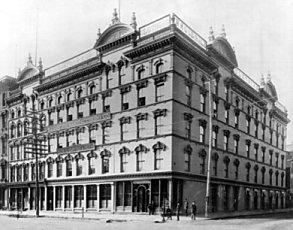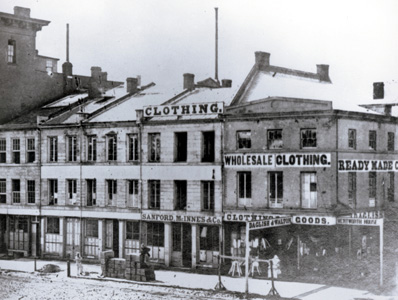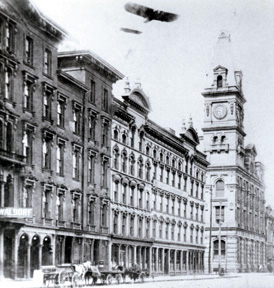(pre-1890 address 47-49 King Street East

THE HEART OF THE CITY
W.E. SANFORD
MANUFACTURING CO. LTD.
88-98
King Street East
(pre-1890 address 47-49 King Street East

![]() BUILDING INFORMATION
BUILDING INFORMATION
Date Built: 1880
Original Owner: W.E. Sanford
Original Use: Clothing Manufacturer
Subsequent Uses: Same
Previous Building on Site: N/A
![]() ARCHITECTURE
ARCHITECTURE
Size: 1880: three-storey; 1910: five-storey
Design and Style: Unknown
Architect, Builder: Unknown
Construction Materials: Unknown
In 1851, W.E. Sanford and Alexander McInnes established a clothing manufacturing company, which was named the Sanford, McInnes & Co. Ltd., and had an initial capital estimated at $2,000. The original building which housed the manufacturing company, located on the corner of King and John Streets, had a frontage of 25 feet, stood three-storeys high, and had a small extension to the rear. This store, being too small, eventually gave way to a larger facility that was four-storeys high, 140 feet deep, and had a frontage of 75 feet. There was also a basement, which ran the entire length of the building.
 During the company’s first year of sales, they earned $32,000. This sum,
over the years, eventually increased to the amount of approximately $1,000,000 per year.
The company employed over 2,000 people in the manufacturing of clothing and was eventually
the largest manufacturer in the Dominion, as well as the leading employer in the area.
Much of the company’s success is due to the skill of its owner. Mr. Sanford pushed
his trade from west to east. He was the first commercial representative to visit the Red
River in the time of Riel, and was the first to travel eastward to the maritime provinces
during the early days of Confederation when Canadians received the coldest welcome
possible.
During the company’s first year of sales, they earned $32,000. This sum,
over the years, eventually increased to the amount of approximately $1,000,000 per year.
The company employed over 2,000 people in the manufacturing of clothing and was eventually
the largest manufacturer in the Dominion, as well as the leading employer in the area.
Much of the company’s success is due to the skill of its owner. Mr. Sanford pushed
his trade from west to east. He was the first commercial representative to visit the Red
River in the time of Riel, and was the first to travel eastward to the maritime provinces
during the early days of Confederation when Canadians received the coldest welcome
possible.
To accompany his drive to seek out new business, Sanford ensured that his shops were fully equipped with all that the mechanical and technological arts could provide. According to the Spectator of April 19, 1915: "The precision and regularity is so uniform in every department that no losses are incurred. The goods are entered into the workroom, and all work going out is charged to the parties who handle it; then the receiving is chargeable until the work is paid for, and if the goods are not in the proper department, they must show up in sales, so that there is no possibility of loss." His company ran like the machines which generated his profits.
In 1871, the partnership between Sanford and McInnes ended, when the latter retired and joined his brother in the wholesale dry goods business. The company, then named "Sanford, Vail and Bickle" continued to thrive and prosper. Only seven years after being invested with a small interest in the business, Mr. Bickle retired, leaving the company as "Sanford, Vail & Company". In 1872, Sanford displayed his entrepreneur spirit by organizing and establishing the Oak Hall Stores, which were to provide an outlet for selling goods produced by his company. In 1884, Mr. Vail retired, and from that day forward, the company was known as "W.E. Sanford Manufacturing Company Limited".
In 1910, the factory occupied #88-98 King Street East and was housed in a five-storey building, having a total floor space of 193,000 square feet. The ground floor was occupied by the general offices, and Mr. Sanford’s private office. Behind these was a fireproof and burglarproof vault. The second floor was divided into several departments, each filled with men’s, youth’s, and children’s clothing. The third floor was filled with piles of goods of every description, while the fourth floor was the working part of the warehouse. The building was equipped with every modern facility for the manufacturing of high-grade men’s, youth’s, and children’s clothing. An example of the fine machinery used by the company were the cutting machines, which cut 100 pairs of pants per hour, or 800 pairs per day, or 350 suits daily, or 500 overcoats daily.
 W.E. Sanford proved to be of a patriotic spirit, which showed itself during the
war years. The Canadian government recognized the quality of goods produced by Sanford,
and as a result, commissioned the company to fabricate military uniforms for troops
overseas. The contract called for the company to make 30,000 khaki serge uniforms for the
troops stationed in South Africa. The uniforms were to be delivered over four months in
lots of 2,000 per week. In addition, any employees of the Sanford Company who enlisted for
service overseas were promised that their positions would be kept for them and that the
company would pay each enlisted employee, the difference between the salary paid to him by
the company, and the pay he was to receive as a soldier.
W.E. Sanford proved to be of a patriotic spirit, which showed itself during the
war years. The Canadian government recognized the quality of goods produced by Sanford,
and as a result, commissioned the company to fabricate military uniforms for troops
overseas. The contract called for the company to make 30,000 khaki serge uniforms for the
troops stationed in South Africa. The uniforms were to be delivered over four months in
lots of 2,000 per week. In addition, any employees of the Sanford Company who enlisted for
service overseas were promised that their positions would be kept for them and that the
company would pay each enlisted employee, the difference between the salary paid to him by
the company, and the pay he was to receive as a soldier.
The Sanford Manufacturing Company was more than just a local business. Sanford had wholesale branches in Hamilton and Winnipeg, as well as sample rooms in Toronto, Montreal, Ottawa, Calgary, Alberta, Vancouver, and other parts of British Columbia. The clothing produced by Sanford was labelled with the name "Sovereign", which was a guarantee of style, quality, and finish. The goods produced by Sanford were regarded as being of the best available in the Dominion, and of the best available in the world.
In 1922, it was announced that the W.E. Sanford Manufacturing Company Limited had decided to go into voluntary liquidation. The company’s failure was associated with heavy purchasing made during and after the war, and the decline in prices in the post-war years. The Oak Hall stores were not affected by the liquidation as they had already passed out of the direct control of Sanford. All the materials owned by the company were sold by auction and the real estate was taken by tender. The fate of the warehouse lay in the hands of the wrecking ball. In the early 1930s, the building was demolished to make room for a large addition to the Royal Connaught Hotel.
REFERENCES: